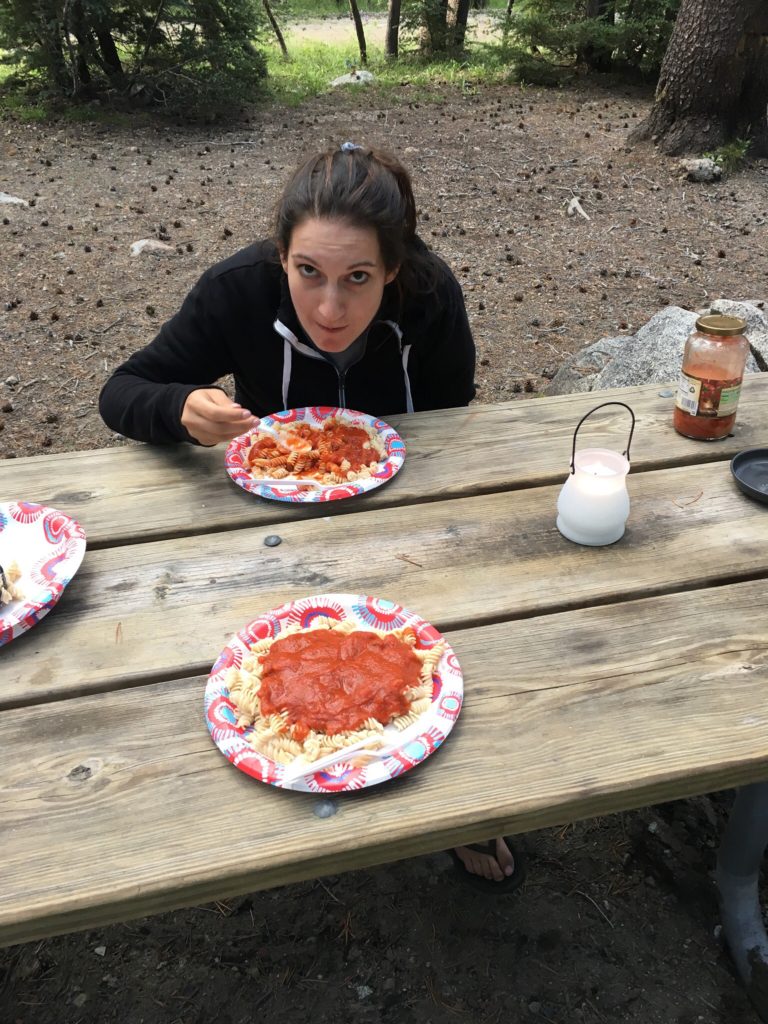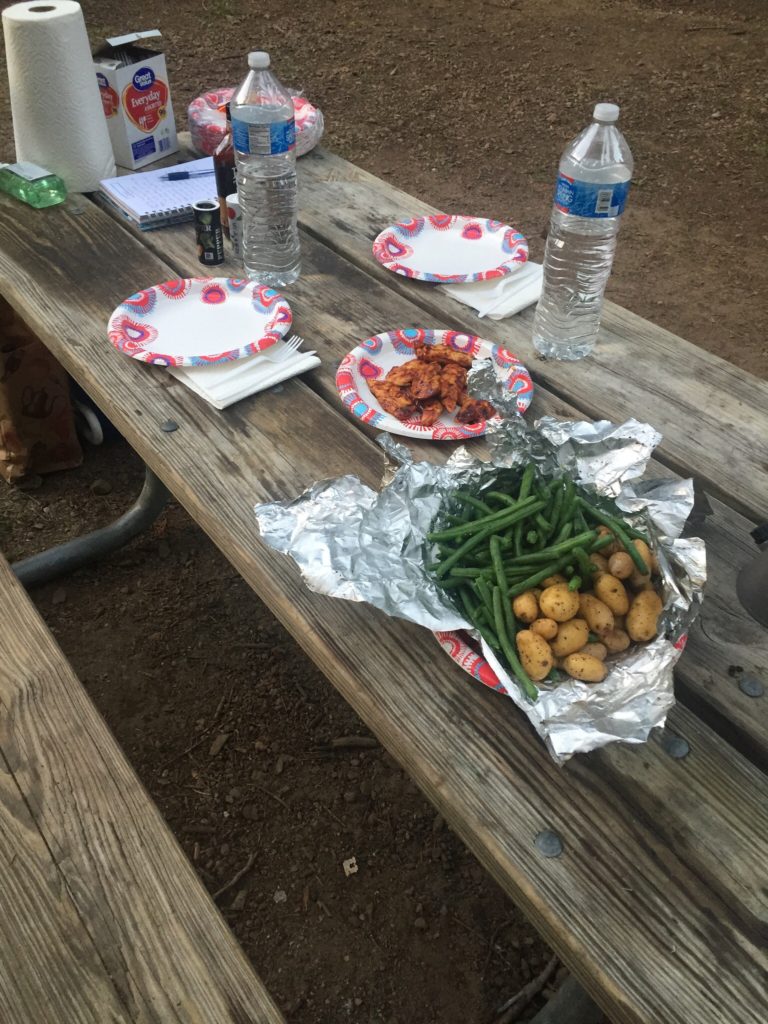My husband and I just celebrated our third wedding anniversary and it has me reminiscing about our special day and the honeymoon that followed. We went on an unconventional honeymoon and spent a week camping in Yosemite National Park. It was the best decision we’ve ever made (aside from marrying each other of course). At the time of our honeymoon, I was only two months into eating gluten free. The idea of flying across the country and camping in the middle of nowhere for a week made me pretty anxious. However, I was determined to figure out the food situation and not let it stop us from going on the trip. To my surprise, it ended up working out better than I expected! I wanted to write up a blog post detailing how we ate gluten free with only a campfire, cooler, and propane burner. So, these are our tips for camping gluten free that we learned from our honeymoon and the other trips we have gone on since!
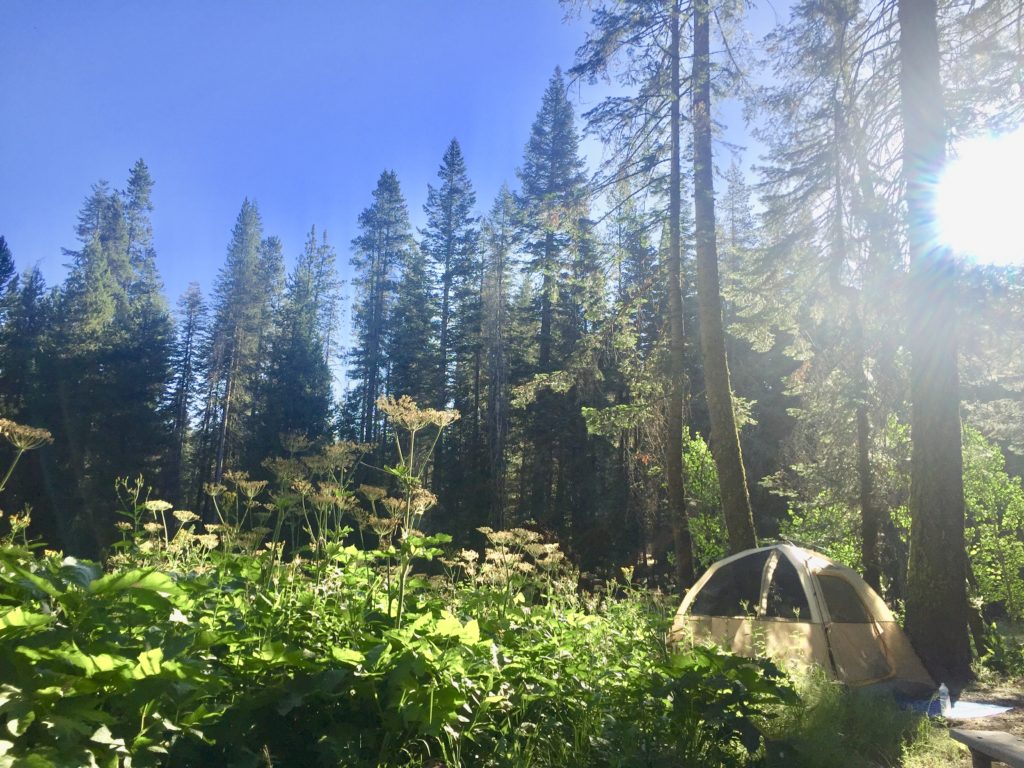
Tip #1: Plan out the menu
I was a planner before my diagnosis, but celiac disease has taken things to a whole new level. Out of all the tips for camping gluten free, planning out what you are going to eat beforehand is my top suggestion. Not only does it help make sure that you will be able to stick to eating gluten free, but it will also ease so much of your stress. I wrote out each day we were going to be camping and then broke it down even further to each meal. I knew that we would be stopping at a grocery store before heading into the park so I also wrote a grocery list so I didn’t have to remember everything we needed. When planning out your menu, consider things like:
- What cooking equipment will you have access to?
- Do you plan on bringing your food with you or buying it once you arrive at your destination?
- What gluten free options are available at your destination (i.e. restaurants, grocery stores, etc.)?
- What foods will make eating gluten free easiest so you can enjoy your trip?
- Will the food on your menu keep for the length of your trip?

Tip #2: Pack food for traveling
This should really be tip #1.5 because it follows the same idea as tip #1. In my experience, you don’t know what to expect on your way to your destination. I don’t necessarily trust that I won’t be cross contaminated along the way even if I do find gluten free food options. Plus, it’s just not worth it to me to risk it and then feel sick the whole trip.
I packed a gluten free peanut butter and jelly sandwich and lots of snacks for the flights. Some of my favorite traveling snacks are trail mix, veggies, fruit, gluten free pretzels, Simple Mills almond flour crackers, and popcorn. The food I prepared could easily be kept in my carry-on bag and nobody stopped or questioned me about it. I also packed more snacks in our luggage just to be safe. I feel most comfortable when I have backup food in case my original plan doesn’t work out.
Tip #3: Bring the cooking equipment you need with you if possible
The only cooking equipment we had for the week was a cooler, propane burner, and the campfire. We brought the burner with us (see the one we got here) but had to buy the propane once we landed. We also packed collapsible pots and pans to use on the burner. On our way to the park, we also stopped to get a cooler. The campfire had the grilling rack and we brought grill mats and foil bags to avoid cross contamination and make grilling easier. When we camp places where we can drive to, we always bring our Weber portable propane grill.
If you don’t want to rely on the grill or campfire, you can also look into dehydrated meals. We did this one night and we were surprised by how good it tasted. Before our trip we went to our local camping store, REI, a few times to see what options we had in terms of cooking equipment and food. This helped us come up with a plan for what to bring with us and what to get once we were in California. We also talked with the employees who gave us their own tips for camping gluten free.
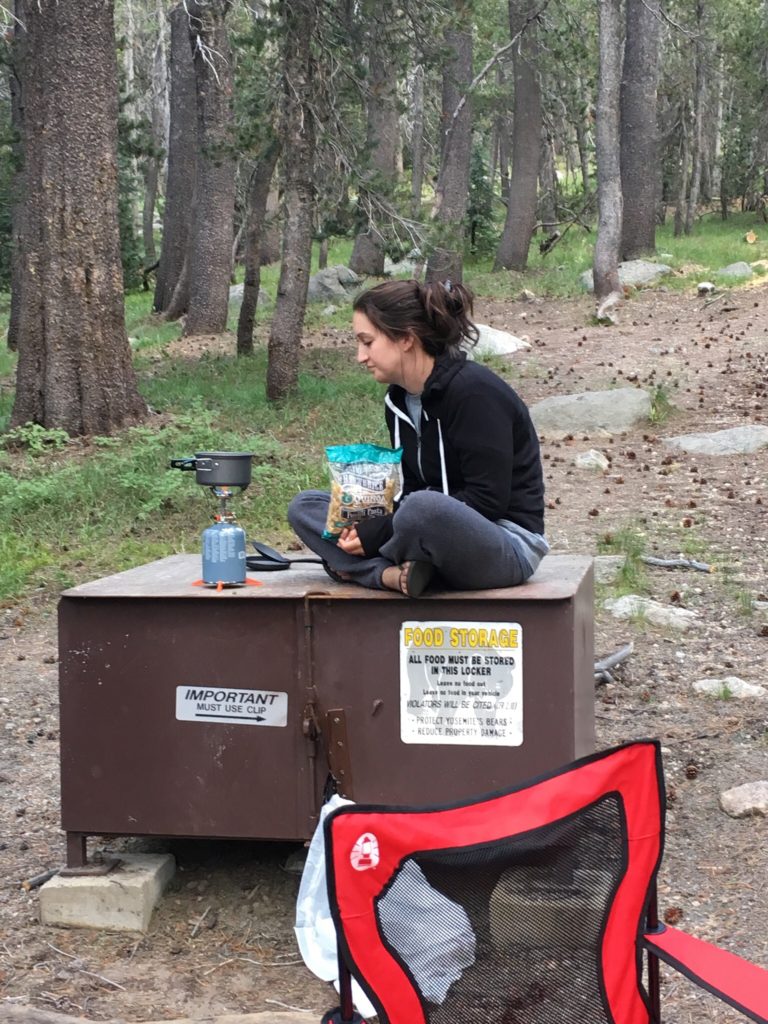
Tip #4: Research gluten free options ahead of time
We were lucky that we flew into San Francisco, California so finding a grocery store with gluten free options was not a challenge. I researched the area ahead of time to scope out the closest grocery stores and picked the one I thought would have the best gluten free options. We stopped at Trader Joe’s before heading to the park and were able to find everything we needed. Since we were somewhat in a rush and I didn’t want to take many risks, we stuck to certified gluten free products if possible. If there are no good gluten free options in the town you are staying in, look at towns close by or along the way if you are driving.
There is also the app Find Me Gluten Free which lets you search for gluten free restaurants near you. Just be warned that not all the places listed are celiac safe so make sure to do a little extra digging before assuming it will be okay. Calling ahead and asking questions is always a good idea! We stayed in a hotel in San Fran the night before we flew home and I used this app to figure out where to eat dinner. I ended up doing additional research once I narrowed it down and picked Chipotle because I felt safest with how they handled it (i.e. wash hands, change gloves, new silverware, etc.).
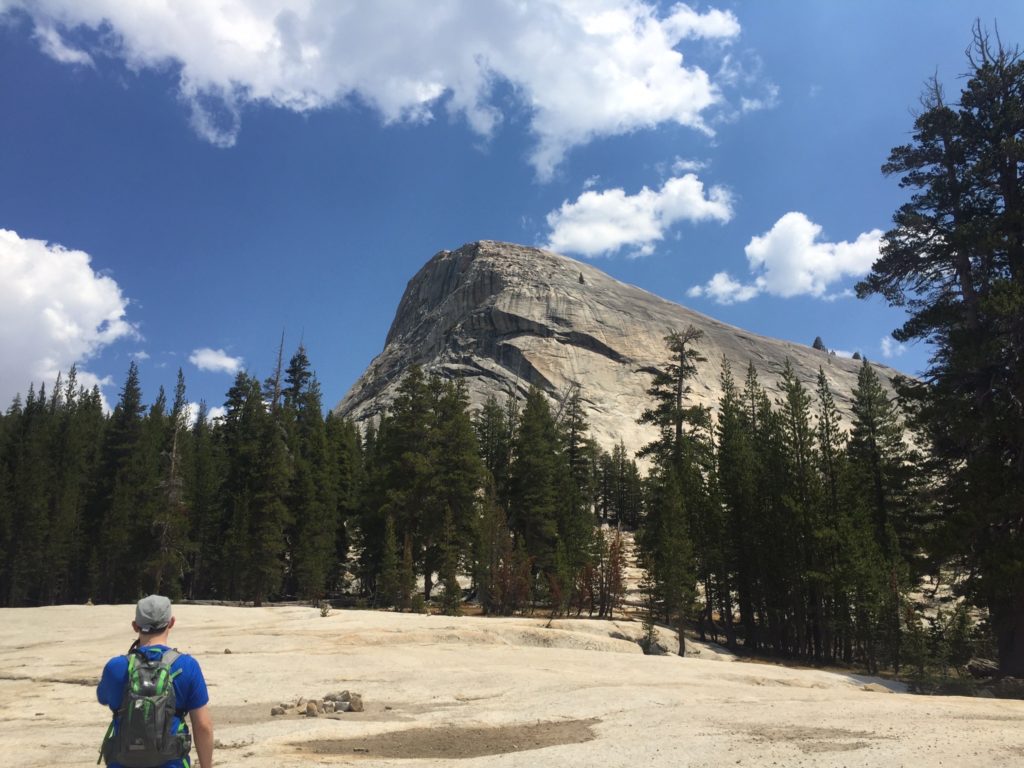
Tip #5: Take into consideration how long your food will last
Before driving into the park, we stopped and bought a cooler to keep our food for the first half of the week cold. We assumed that we wouldn’t be able to get more ice in the park so we planned our menu accordingly. The first two days we ate the foods in our cooler as they wouldn’t last long without replenishing the ice. The rest of the week consisted of foods that didn’t need a cooler.
We ended up finding a little shop in the park on our way to our second campsite that sold ice so we were able to keep the food in the cooler longer than we expected. Even if you will have the option to keep your food cold the whole trip, consider bringing some food options that don’t need to be kept cold or be cooked. It’s always good to have a backup plan just in case!
Tip #6: Live in the moment
I know how easy it is to obsess over food and let it consume your every thought. What am I going to eat next? Will I run out of my gluten free food? What if I didn’t look at the ingredients thoroughly? I’ve been there and still struggle with this at times. But I also truly believe that we can’t let celiac disease or any other dietary restriction take away from enjoying life and living in the moment. So, that’s my last tip about camping (and living) gluten free. Plan ahead of time, do your best with what you got and then forget about it. Let yourself relax and enjoy the trip.
I was so nervous leading up to this trip but, honestly, once we were there it’s like I almost forgot about it. I knew all the food we had at the campsite was safe because we either brought it with us or bought it ourselves. This helped me to stay out of my head and focus on experiencing the nature, views and beauty we were surrounded by. Figuring out what works best for you when camping or traveling gluten free will help in this area too. I know for myself, the more practice I have, the easier it gets and less stressed I feel.

Gluten free camping menu
Dinner:
- BBQ chicken, green beans and potatoes. We grilled the chicken over the campfire using the grill mat. The green beans and potatoes were cooked in the foil bags over the campfire.
- Turkey burgers with gluten free buns, carrots and rice. We used the grill mats to grill the turkey burgers over the campfire. We then used the grill foil bags to cook the carrots over the campfire. The rice was cooked using the propane burner.
- Gluten free noodles with marinara sauce. We made this meal two nights and used the propane burner to make it. We made the noodles first and then heated up the marinara sauce.
- Dehydrated chicken fajitas with rice. We used the propane burner to heat up both the chicken fajitas and rice.
Lunch:
- Peanut butter jelly/fluff sandwiches on gluten free bread
- Turkey and cheese sandwiches on gluten free bread (beginning of the week while it kept cold in the cooler)
- Fruit pouches
- Carrots
- Chips/popcorn
Breakfast:
- Gluten free bagels (we used the propane burner to toast them and the butter kept in the cooler most of the week)
- Meal replacement bars (we love Probar Meal Bars-they are certified gluten free)
Snacks:
- Pudding cups
- Popcorn
- Meal replacement bars
- Gluten free pretzels
My personal takeaways for camping gluten free
Gluten free camping is easier than you might think.
After my diagnosis, I was hesitant about our plan for our honeymoon. I thought that it was going to be really hard eating gluten free while camping for a week. When we were flying home, I realized it ended up turning out to be the opposite of what I expected. It was actually easier to control what I ate because I bought and handled all my food. There was no risk for cross contamination or being accidentally glutened. There is definitely more work before the trip in terms of planning it all out, but once we were camping it was pretty easy.
Write in a journal.
We kept a journal and wrote in it several times a day to document our trip. We love pulling it out and reading through it every so often. It takes us right back to that amazing week. I made sure to write down what we ate each day and the tips for camping gluten free we were learning along the way. I’m so glad I did this because it has helped with planning future trips. I remember what meals we ate, what worked and what we could have done better. It also reminds me that traveling gluten free is possible. I flew across the country, ate gluten free, didn’t get sick and had an amazing week.
Fear is good, lean into it.
In just about every journal entry, we wrote “fear is good”. We weren’t your avid adventurers before this trip. We only camped locally twice before our honeymoon. So, this was a big trip for us and we were definitely winging it. We learned that fear is good and that we should lean into it because on the other side of it is great things.
If we didn’t lean into our fear, we wouldn’t have experienced what we did that week. I know this seems like I am rambling about our trip, but it relates to celiac disease or really any type of health issue. It’s okay to fear food, social events, trips, symptoms, etc. but learn to lean into that instead of letting it control you. I know I let it control me for so long and it is something I am still working. But I also know that I’m happiest when I see what’s on the other side of that fear.
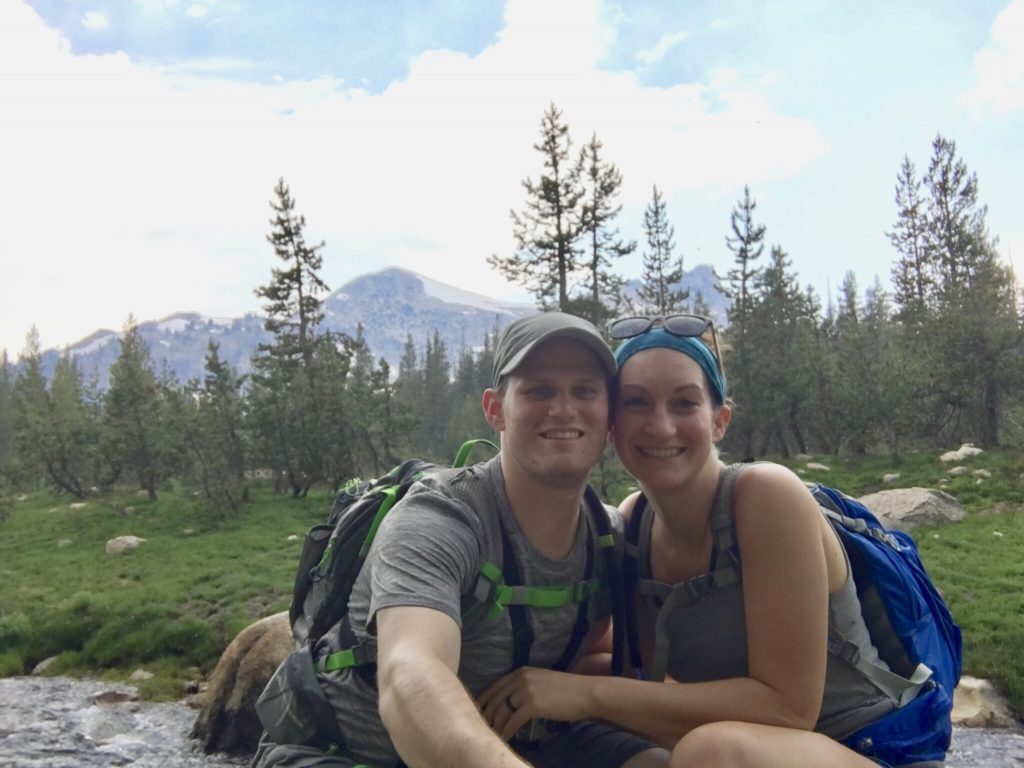
Nature is healing.
The year and a half leading up to our honeymoon was not easy. My symptoms kicked me down and turned my life inside out. At the time of our trip, I still had a lot of healing to do both physically and emotionally. My body was adjusting to gluten free life and starting to feel better but definitely not 100%. I was also still experiencing the anxiety from everything I went through and had a lot of fear around food. Being able to unplug from life for a week and be surrounded by nature was so healing for me. It helped me start to reconnect with myself and my body.

These tips for camping gluten free can also be applied to traveling gluten free in general! If you have your own tips, let me know by commenting below!
-Kelsey

